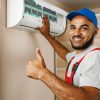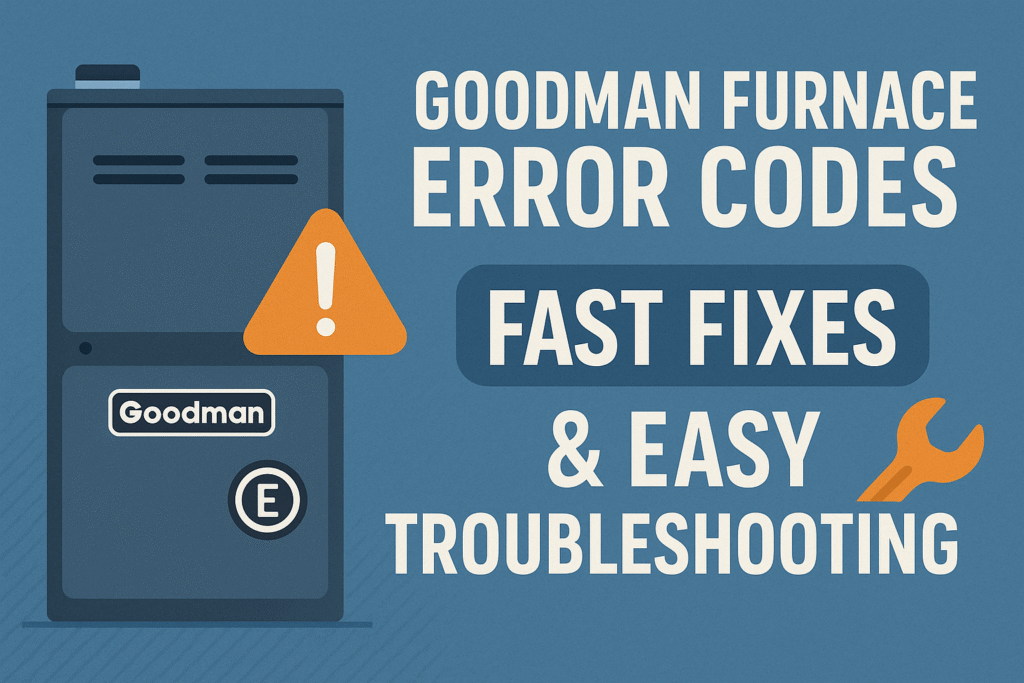Goodman furnaces are known for their energy efficiency, durability, and dependable performance. But like any sophisticated heating system, they can occasionally run into operational issues. Fortunately, Goodman furnaces are equipped with a built-in LED diagnostic system that makes troubleshooting more manageable—even for homeowners.
This comprehensive guide will help you understand Goodman furnace error codes, identify the causes, and determine whether it’s a DIY fix or time to call a professional.
How Goodman Furnace Error Codes Work
Your Goodman furnace uses a control board with LED indicator lights that blink in specific sequences. Each blinking pattern represents a unique diagnostic error code, designed to help you quickly pinpoint the underlying issue.
Here’s how to interpret these LED signals:
- Blinking LEDs: Indicate a system fault or malfunction.
- Steady LEDs: Show normal operation or basic standby status.
- Rapid Blinking: Suggests a serious issue, such as a safety fault.
Most Goodman furnace models include a reference chart inside the access panel. If yours is missing or faded, use this detailed guide below to decode the error codes and respond appropriately.
Single Flash Error Codes
These typically point to relatively minor issues, often related to ignition or the pressure switch.
| Code | Meaning | What to do |
1 Flash | Ignition failed; system in lockout mode. | Check and clean the flame sensor, ensure the gas supply is on, or replace the igniter. |
| 2 Flash | Pressure switch stuck closed or open. | Inspect the venting system for blockages, check the tubing, and test the pressure switch. |
Double Flash Error Codes
These error codes are generally triggered by overheating or airflow restrictions.
| Code | Meaning | What to do |
3 Flash | Limit switch open (overheating detected) | Replace dirty air filters, unblock vents, and improve airflow across the unit. |
| 4 Flash | High-limit switch open | Clean the blower motor, check for duct blockages, and inspect the return air pathways. |
Multiple Flash Error Codes
These are usually more serious issues that require expert diagnosis and repair.
| Code | Meaning | What to do |
5 Flash | Flame detected when burners are off | Could indicate a gas valve leak—call a professional to inspect and repair. |
| 6 Flash | Rollout switch open (possible fire hazard) | Turn off the furnace and contact an HVAC technician immediately for a safety check. |
| 7 Flash | It could indicate a gas valve leak. Call a professional to inspect and repair it. | Turn off the furnace and contact an HVAC technician immediately for a safety check. |
Steady LED Indicator States
Even when no error code is displayed, the LED can provide useful status updates.
| LED Status | Meaning | What to do |
Steady On | The furnace is operating or in standby mode | No action needed unless the unit fails to heat your home. |
Steady Off | No power to the control board | Check the circuit breaker, power switch, and inspect for blown fuses. |
Rapid or Continuous Flashing
If your furnace LED is blinking rapidly or continuously, it likely means a severe issue is at hand.
| LED Status | Meaning | What to do |
| Continuous Flashes | Control board in diagnostic/fault mode | Turn off the furnace for 10 minutes. If the issue remains after rebooting, call a technician. |
| Rapid Blinking | Critical safety fault detected | Shut off the furnace immediately and call for emergency service. Do not attempt DIY repairs. |
What If There’s No LED Display at All?
If your furnace isn’t showing any LED lights:
- Verify power: Make sure the furnace is plugged in and the circuit breaker hasn’t tripped.
- Check for a blown fuse: A bad fuse can interrupt power to the control board.
- Test the control board: If everything else appears fine, the control board may be defective and require replacement.
How to Prevent Goodman Furnace Error Codes
Many furnace issues can be avoided with regular preventive maintenance. Taking a few simple steps can keep your system running efficiently and reduce the risk of future breakdowns:
1. Change Air Filters Regularly
Dirty air filters restrict airflow and can cause overheating or system lockouts. Check your filter monthly and replace it every 1 to 3 months, depending on usage and indoor air quality.
2. Keep Vents and Registers Clear
Blocked supply or return vents reduce airflow, forcing the furnace to work harder. Ensure no furniture, curtains, or rugs are covering your vents.
3. Schedule Annual Furnace Maintenance
Have a certified HVAC technician inspect and tune up your system every year, preferably before winter. They’ll clean components, check electrical connections, lubricate moving parts, and test safety mechanisms.
4. Clean the Flame Sensor
The flame sensor can accumulate buildup over time, causing ignition failure. Use fine-grit sandpaper to gently clean the sensor once per heating season.
5. Inspect Your Thermostat
Make sure it’s properly calibrated and functional. Replace batteries annually and confirm it’s securely wired if it’s a wall-mounted unit.
6. Flush the Condensate Drain Line
If your unit is a high-efficiency model, it may have a condensate line that can become clogged. Clean it out regularly to prevent pressure switch errors.
7. Keep the Furnace Area Clean
Avoid storing boxes, chemicals, or any flammable materials near your furnace. A clutter-free environment improves safety and airflow.
When to Call an HVAC Technician
While some furnace issues are easy to address on your own, others require professional attention to ensure safe and lasting repairs. Contact a licensed technician if:
- Error codes keep returning after resetting the unit
- The furnace short cycles, won’t turn on, or turns off unexpectedly
- You hear unusual noises such as banging, screeching, or humming
- You detect a burning or gas odor (shut off the unit and leave the area immediately)
- The LED display is unresponsive, indicating a possible control board failure
Attempting complex repairs without proper training can result in further damage or safety risks. A professional HVAC technician can quickly identify the root of the issue and offer safe, efficient solutions.
Final Thoughts
Goodman furnaces are designed for longevity and reliability, but no system is completely trouble-free. Understanding the LED diagnostic system and common error codes empowers you to take action—whether that’s replacing a filter, cleaning a sensor, or calling in an expert.
Preventive maintenance remains your best defense against unexpected furnace problems. With regular care and timely attention to warning signs, your Goodman furnace will keep your home warm and comfortable through every winter season.
Need expert help now? Call our certified HVAC team for fast, affordable, and professional furnace repair you can trust.


